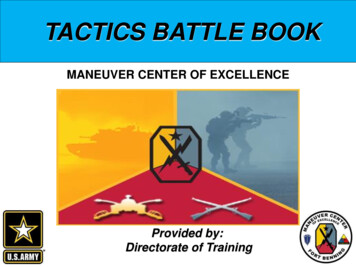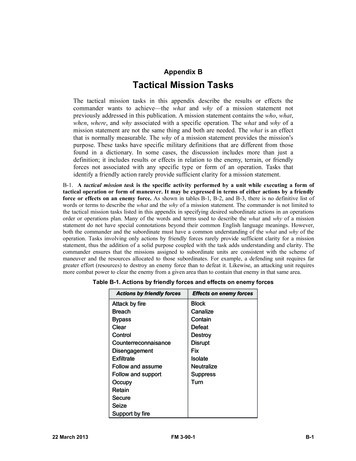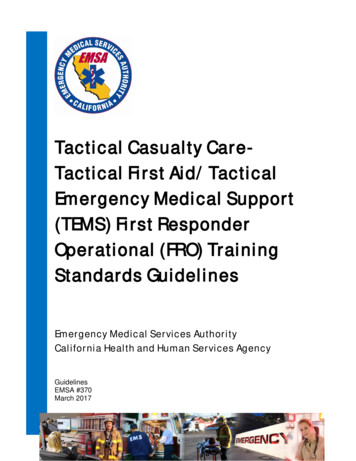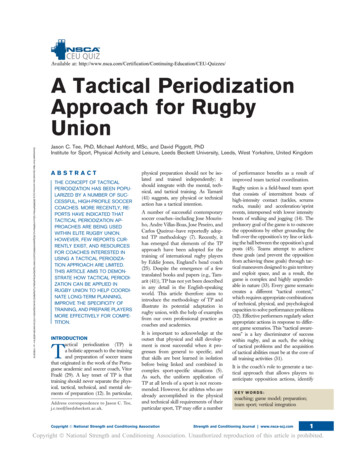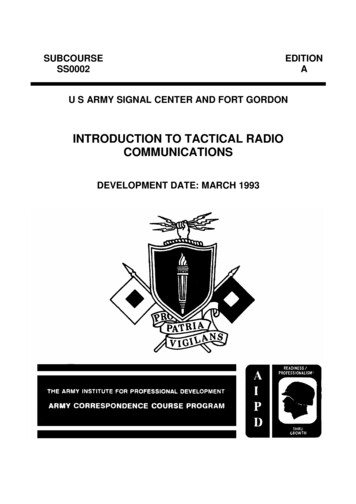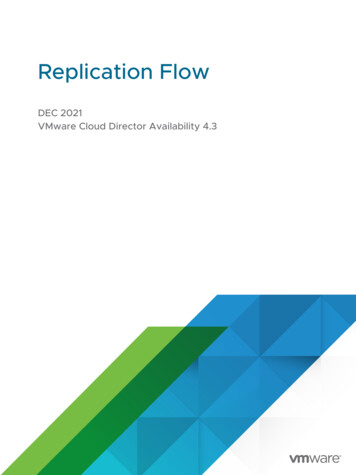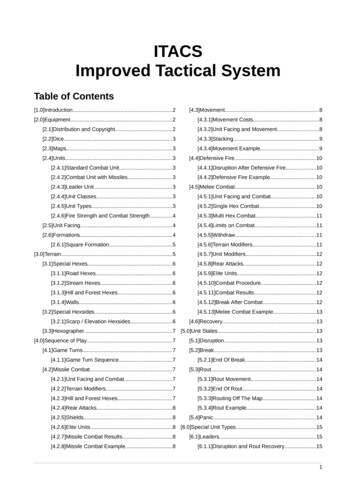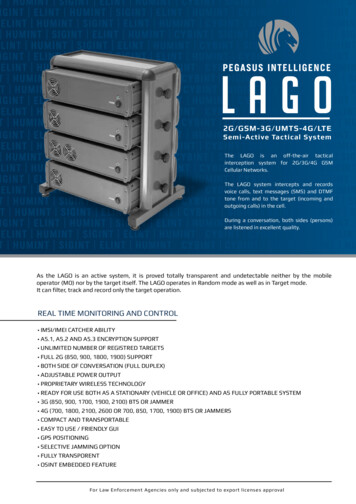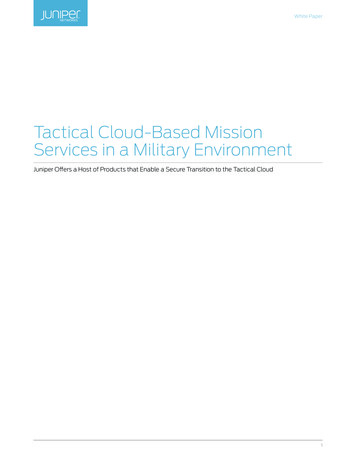
Transcription
White PaperTactical Cloud-Based MissionServices in a Military EnvironmentJuniper Offers a Host of Products that Enable a Secure Transition to the Tactical Cloud1
Tactical Cloud-Based Mission Services in a Military EnvironmentWhite PaperTable of ContentsIntroduction. 3Evolution of the Tactical Cloud. 5NetOps Transformation for the Tactical Cloud. 9Network Virtualization, Software-Defined Networking, and the Tactical Cloud. 10How Juniper Supports Transformation to the Tactical Cloud .11Simplifying NetOps and Improving Performance.11Providing a Common Foundation to Automate NetOps Management.12Creating an Agile Infrastructure.14Secure Gateway Router for Inter-Unit Connectivity. 20Secure Network Access . 20Wireless Access. 22Optimizations for Networking on the Move (NOTM). 22SDN and SON. 22Commercial Off-the-Shelf (COTS)-Based Multisite VPN. 23SDN and Cloudlet Cyber Foraging.24Conclusion.25About Juniper Networks.26List of FiguresFigure 1: Tactical cloud environment overview. 5Figure 2: Elements of the tactical cloud. 6Figure 3: Tiers of the ITNE.7Figure 4: UAS connections for the tactical cloud Networking on the Move (NOTM). 8Figure 5: QFabric System flattens and simplifies the TOC architecture.12Figure 6: Junos Space and Security Director.13Figure 7: Junos Space Virtual Director architecture.13Figure 8: Role of Contrail in the tactical cloud.14Figure 9: Contrail vRouter.15Figure 10: vRouter forwarding plane. 16Figure 11: Juniper NFV security services. 18Figure 12: Firefly Host virtualized functions. 18Figure 13: Firefly Perimeter virtual functions. 19Figure 14: Transformed TOC leveraging SDN and NFV capabilities. 19Figure 15: Role of MAP server.21Figure 16: Integration of SDN with SON.23Figure 17: COTS-based Multi-site VPN.24Figure 18: Cloudlet concept.25 2015, Juniper Networks, Inc.2
Tactical Cloud-Based Mission Services in a Military EnvironmentWhite PaperThe military’s tactical environment is evolving quickly due to technology advances designed to adapt tactics tomatch adversary capabilities. There is also the need to address contested, non-permissive environments; to increaseoperational efficiencies; to improve the commander’s decision quality; and to enhance situational awareness. Thesechanges are having a profound impact on the architecture of the tactical network resulting in the need for a highly agileinfrastructure; resilient, persistent, and high bandwidth communications; and secure connectivity.The tactical cloud has started to emerge as a key concept for delivering agile and resilient information services totactical forces. A tactical cloud-like environment offers needed technology enhancements, and its capabilities enablethe fluid sense-and-respond services that are essential at the tactical edge.This paper lays out the evolution of tactical cloud-based mission services accessible on the move. It identifies some ofthe key drivers for pursuing tactical cloud capabilities and provides descriptions of networking requirements needed tosupport this evolution. The paper concludes by illustrating how Juniper technologies can be applied to support a tacticalcloud “on the move.”IntroductionThe following real-world vignettes help to demonstrate how aspects of a tactical cloud can deliver the capabilities thata tactical environment requires to meet quickly-evolving needs: The Commanding Officer of the USS Wasp just received a new mission package that changes the configurationsand security profile of his shipboard tactical network, while also requiring the provisioning of new applicationupdates. Despite efficiencies provided by Consolidated Afloat Network and Enterprise Services (CANES) andAutomated Defense Network System (ADNS), he is worried that required changes will necessitate hours if notdays to implement in his network, and to synchronize the changes with the tactical networks of the air wing andamphibious units deployed onboard, as well as with other ships in the amphibious task force. The combat systemsinformation officer informs him that recent updates to CANES and ADNS included software-defined networking(SDN), which can integrate the application updates in the virtualized CANES infrastructure with the network andeasily synchronize the changes in the mission package. A Marine squad leader has just finished interrogating a local native in a village where an IED production facility wasrecently discovered. The villager’s fingerprints and facial biometrics were captured by applications on the squadleader’s smartphone. Although he is disconnected from the Tactical Operations Center (TOC) where the centralbiometrics database is located, he is able to connect to his LAV-25 that hosts a “cloudlet” able to process thebiometrics he has collected for a rapid check. The Combat Systems Information Officer of the USS Lincoln needs to replace a rack of CANES servers that hostvirtualized workloads without experiencing any downtime. The virtualized servers support a variety of tenants’applications. She decides to migrate the workloads to different underutilized servers through virtual machine(VM) migration. She also leverages Layer 2 over Layer 3 (L2oL3) overlay technologies provided through SDN andvirtualized network functions to rapidly migrate the network connectivity and security protections (e.g., virtualfirewall) at the same time. L2oL3 capability allows her to utilize the proven scalability of L3 addressing andmultipathing technologies of the underlying physical layer, while also creating separate virtual L2 networks that canthen be assigned to each tenant. She also knows that the security of the multitenant virtual workloads is assuredthrough the virtual gateway that is integrated with each hypervisor in the CANES infrastructure. The virtual gatewaysecurity policy is synchronized with firewalls that control north-south traffic, and it ensures that inter-VM traffic iscontrolled appropriately. A critical video is being multicast by the USS Lincoln to members of the Carrier Task Force. As the number of usersthat access the video increases, the SDN controller senses resource capacity issues on the video server nodes andbandwidth bottlenecks on the routers. The SDN controller directs the VM orchestrator to provision a new cluster ofvideo server VMs. Also, a new virtual firewall and virtual gateway are provisioned as part of the overall service chainto the virtual video server nodes. SDN-aware routers and gateway switches are also updated via direction providedby the SDN controller for quality-of-service (QoS) changes related to the new traffic flows.As these example vignettes indicate, the tactical edge is characterized as a highly dynamic environment with forceson the move, unpredictable changes in operational tempo and fluctuations in network connectivity, bursty informationflows, and frequent modifications to mission plans and force elements. These variations necessitate a high degree ofresiliency and agility in operations, while placing significant operational and technical constraints on the underlyingcomputing and networking infrastructure of the tactical edge. 2015, Juniper Networks, Inc.3
Tactical Cloud-Based Mission Services in a Military EnvironmentWhite PaperThus, the tactical cloud has started to emerge as a key concept for delivering agile and resilient information services totactical forces. As per the NIST definition, a tactical cloud can deliver several important capabilities:1.On-demand self-service. A consumer can provision computing capabilities automatically, without requiring humaninteraction with a cloud service provider.2. Broad network access. Capabilities are available over the network and accessed through standard mechanisms thatpromote use by heterogeneous client platforms (e.g., mobile phones, tablets, laptops, and workstations).3. Resource pooling. The provider’s computing resources are pooled to serve multiple consumers using a multitenantmodel, with different physical and virtual resources dynamically assigned and reassigned according to consumerdemand.4. Rapid elasticity. Capabilities can be elastically provisioned and released, in some cases automatically, to scalerapidly outward and inward commensurate with demand. To the consumer, the capabilities available for provisioningoften appear unlimited and can be appropriated in any quantity at any time.5. Measured service. Cloud systems automatically control and optimize resource use by leveraging a meteringcapability at some level of abstraction appropriate to the type of service (e.g., storage, processing, bandwidth, andactive user accounts). Resource usage can be monitored, controlled, and reported, providing transparency for boththe provider and consumer of the utilized service.These capabilities enable the fluid sense-and-respond services that are essential at the tactical edge.The tactical cloud provides services-offload for the enterprise cloud, while also enabling specific on-demand tacticalservices for users. Infrastructure elements of the tactical cloud can be either fixed (stationary) or mobile, and leveragevirtualization to the maximum extent possible to meet Space, Weight, and Power (SWaP) constraints often imposedby tactical operations. In general, the tactical cloud infrastructure does not have to be proximate to the tactical cloudservice consumer; however, uncertainty in the state of last mile networking links that can create a Disconnected,Intermittent, Limited bandwidth (DIL) environment, often dictates that tactical cloud services be provisioned in closeproximity to the tactical end user.Communications in the tactical environment vary widely depending on the environment and the communicationsplatform, and can include standard commercial and specialized waveforms to enable IP wireless/wireline, satellite,microwave, and military radio frequency (RF) signaling capabilities. In general, tactical end users are connected throughmobile ad hoc networks (MANETs) using IP-based software-defined radios (SDRs). Data processing devices such assmartphones and tablets are tethered to these radios.“Sensor clouds” consisting of netted sea, air, space, human-wearable, and ground-based sensors capture and relaysituational awareness data for a variety of needs directly to tactical end users, and/or to cue other sensors, or todata processing nodes of the tactical and enterprise clouds. Mobile cloud computing nodes provide on-the-moveInfrastructure as a Service (IaaS), Platform as a Service (PaaS), and Software as a Service (SaaS) to tactical users. Forexample, mobile command post services may be offered at these nodes. Cloudlets are special types of mobile cloudcomputing nodes that offload compute-intensive functions from tactical users’ smartphones or tablets. Cloudlet usersare generally “one-hop” distance from cloudlets and can offload compute-intensive services through a method calledVM synthesis.The tactical cloud provides fixed location (e.g., containerized) or mobile (e.g., shipboard) cloud services for an overallarea of responsibility in the tactical environment. It enables backbone network services and access points to otherenterprise cloud services. It also includes cloud management services as part of an operations center to ensure thedelivery of cloud services. 2015, Juniper Networks, Inc.4
Tactical Cloud-Based Mission Services in a Military EnvironmentWhite PaperFigure 1 depicts the relationship between various elements of the tactical cloud environment (in blue).EnterpriseCloudEnterpriseCloudTactical Cloud /OperationsCenterDIL EnvironmentMobile TacticalCloud Node /CloudletsDIL EnvironmentMobile TacticalCloud Node /CloudletsSensor Cloud / MANETFigure 1: Tactical cloud environment overviewThe tactical cloud provides IaaS, PaaS, and SaaS across a variety of tactical computing nodes and uses discoveryservices, virtualization, VM synthesis, VM migration and on-demand provisioning, and intelligent networking services todeliver cloud services to the edge. Juniper offers a variety of virtualized networking and security functions that can beused to reduce SWaP ratios and to provide secure networking capabilities for the tactical cloud. In addition, these virtualservices can be directed and managed by Juniper Networks Contrail—an SDN solution which integrates with the mostpopular VM orchestration tools such as vCenter Orchestrator from VMware, OpenStack, and CloudStack. This paperhighlights how the tactical cloud can be enabled with these technologies.Evolution of the Tactical CloudThe Integrated Tactical Network Environment (ITNE) is evolving to IP networking to support net-centric warfare anddata-centric capabilities that link knowledgeable entities in the battlespace. Information is passed over the tactical edgenetworks to: 1) enable situational awareness; 2) collaborate; and, 3) plan, command, control, and execute missions.For example, the tactical edge networks are the primary feed to support the common tactical picture (CTP). The CTPcontains information spanning the spectrum from the sensor to the shooter to the decision maker, and is a visualrepresentation of the information contained within the databases of the tactical edge subnetworks. Figure 2 notionallydepicts some of the key elements that form the ITNE. 2015, Juniper Networks, Inc.5
Tactical Cloud-Based Mission Services in a Military EnvironmentWhite PaperPerimeter Securityand TrackingMobile Apps StoreCellular NetworksRemote Sensingand ControlTactical CloudServicesCommand Center/Tactical OperationsIn-VehicleComputersEmbeddedWiFi TechnologyVideo Streamingand AnalyticsFigure 2: Elements of the tactical cloudThe ITNE is designed to provide three levels of network services within the battlespace. One service level (combattier) supports a mobile ad hoc wireless networking capability to enable just-in-time connectivity among highlymobile ground users, netted sensors, and sea- or air-based mobile platforms. The second service level (core tier)supports a high bandwidth backbone service to interconnect larger Command and Control, Intelligence, Surveillance,and Reconnaissance (C2ISR) nodes in the battlespace. The backbone enables reuse of available non-SatelliteCommunications (SATCOM) bandwidth. The third service level (reachback tier) supports beyond line of sightcommunications into Global Information Grid (GIG) points of presence. 2015, Juniper Networks, Inc.6
Tactical Cloud-Based Mission Services in a Military EnvironmentWhite PaperTeleport/STEPPost/Camp/StationAt Home/TDYInternetGlobal DefenseNetworkSatelliteTransportReachbackTierCore TierCombat TierUASCombat TierFigure 3: Tiers of the ITNEOne of the key challenges affecting the evolution of the ITNE to a tactical cloud environment is that the advancedcommunications capabilities that underpin tactical operations might not be available in a conflict (e.g., SATCOM orbroadband connectivity to backbone). Instead, an adversary could induce a DIL scenario, which could affect all tiers,although the combat tier is most affected by DIL situations. At the combat tier, small groups of platforms or individualusers are interconnected for relatively short periods of time (hours) under conditions where the mobility of the platformsand users has the potential for extremely frequent changes in link connectivity. These MANETs are generally constrainedwith respect to onboard resources and environmental conditions, so the only networking services performed in thistier are those that are absolutely essential. The resource limited constraints in these combat tier networks require thatrespective nodes retain limited global knowledge of the battlespace, opportunistically communicate with other nodes,and make efficient use of the scarce available bandwidth.A DIL scenario may negatively affect the operation of cloud services delivered to the battlespace. Generally, cloudservices are offered in situations where bandwidth is not a limiting factor on their delivery. However, the design of atactical cloud must be tailored to support bandwidth-constrained, space/weight-constrained, and power-constrainedenvironments, while being able to scale up, scale out, and scale down quickly.MANET technologies are likely to progress over the next several years from advanced RF networks utilizing SoldierRadio Waveform (SRW) and Wideband Networking Waveform (WNW), to also include mobile IP-based networks,Network Mobility (NEMO), LTE 4G, Cloud RAN, RAN 2.0, variants of these and other network technologies currentlyunder development. Also, aerial platforms such as Unmanned Aerial Systems (UAS) are already being introduced intothe networked MANET environments to enable higher bandwidth services including C2ISR ((such as full motion video(FMV)), reachback to the GIG, inter-unit communications, and backbone connectivity. Figure 4 illustrates this wide rangeof UAS connectivity of the combat tier. 2015, Juniper Networks, Inc.7
Tactical Cloud-Based Mission Services in a Military EnvironmentWhite PaperTDL NetworkTDL NetworkSurveillance AircraftFighter AIrcraftMid-Tier UAVMid-Tier UAVNaval ShipSurveillance AircraftUpper-Tier UAVSoldiersSoldiersConvoyVoice/Data Radio CommForward OperatingBaseTDL CommFigure 4: UAS connections for the tactical cloud Networking on the Move (NOTM)Different deployments of the tactical cloud will require protocol suite selection and network optimization with emphasison different drivers to meet mission plans and objectives. Some of these technical drivers that impact tactical cloudnetwork services include: Network scalability and availability requirements Deployment of mobile compute nodes, such as LTE-based smartphones, and IP-based SDRs that support peerto-peer routing Ability to support rapid network convergence as nodes enter or leave the network, along with secure reconnectpolicies Visibility of a network node’s role and tier, geo-location, and security state Ability to support anti-jamming and interference management User device capacity constraints and power limitations IP address space allocation limitations Requirements for access, transport, and data-at-rest encryption Wireless spectrum constraints and dynamic spectrum access requirements by mobile units Data transmission rates, compression ratios, and formats (e.g., file-based vs. streaming) Objective application needs (latency, jitter, store and forward, authentication, data formats, etc.) Attributes of the user, device, and application accessing (and/or delivered by) the tactical cloud Sensitivity of the data or resources being accessed by the user and/or stored in the cloud Degree of peer-to-peer information sharing, multicast groups, content-based networking, etc. Interoperable security gateways to support coalition activity (e.g., Future Mission Network)Optimizing this set of parameters for delivery of service capabilities is complicated enough for static, high-bandwidth,wireline infrastructures. For wireline environments, the network typically will include many redundant links that can beemployed quickly to support net-centric services by invoking capacity management protocols at the link layer or at thenetwork layer. However, tactical clouds are highly dynamic in response to changing mission events, resulting in changingcommunication patterns. For example, in the combat tier’s mobile wireless communications environment, users andnetwork nodes connect and disconnect frequently, wireless communications may become disrupted by environmentaland/or battlespace conditions, and bandwidth is often limited or can suddenly wax and wane. In addition, the luxury oflink overprovisioning typically does not exist and maneuvers also disrupt communication. 2015, Juniper Networks, Inc.8
Tactical Cloud-Based Mission Services in a Military EnvironmentWhite PaperThe fluid environment of the tactical cloud necessitates visibility and control of networked resources at a logical level,and topology simplification and convergence of resources at the physical layer. Therefore, tactical communicationscan benefit by employing virtual network services that are delivered using cross-layer network design and cross-layeroptimization protocols. Cross-layer approaches ensure the discoverability of attributes across different layers of thecommunication stack; help to isolate or connect virtual network services; and provide feedback on concurrent qualityinformation for the responsive setting of control parameters. In addition, a tactical cloud must be adaptive to anyunderlying (physical) network infrastructure. It must support applications and services implemented with all identifiablepermutations of current technology and work with any vendor.NetOps Transformation for the Tactical CloudThe Tactical Operations Center is a hub for tactical cloud management services. Various cloud mission services, andnetwork and security management activities for the battlespace will reside here. The TOC provides fixed backbonenetworking between the different MANETs of the combat tier, gateways for legacy networks, and reachback services to amilitary service entry point.TOC network planners and administrators currently face many complexities in establishing an ITNE for the battlespace.A myriad of platforms, applications, routing schemes, network associations, spectrum allocations, and informationelements must be evaluated against the mission plan, as well as configured and implemented as part of a complexnetwork operations plan. Planning is hampered by stovepiped processes that drive the need for a large number of toolsto manage the network. Current network components are initialized in different ways using different tools. The lack ofcommon federated NetOps interfaces also inhibits dynamic operations (e.g., combat loss leading to unit reorganization).As a result, the effort required to adequately plan, configure, and implement the unique requirements of the network permission plan can be enormously time-consuming as well as costly to develop and maintain the necessary skills.TOC operators also have many challenges keeping the network running and doing their jobs efficiently. Everyday taskssuch as monitoring devices, troubleshooting, maintaining security, and software upgrades are increasingly difficult asthe number of independent devices in the network increase. Such fault, configuration, accounting, performance, andsecurity (FCAPS) operational challenges are further compounded if these devices are running different versions ofsoftware or have different configurations, since software must be carefully managed across devices to ensure consistentfunctionality and to limit exposure to bugs or handle other Information Assurance Vulnerability Alerts (IAVAs). Specialtraining or expertise may also be needed to support these configurations. In addition, equipment is moving out of theTOC and into lower echelons of the C2 hierarchy; however, the personnel who staff that equipment are not alwaysmoving down to those lower echelons.Besides these planning and operational challenges, the complexities created by the multitiered networks of today’sTOCs also lead to increased latency, delays in network convergence, and limited bandwidth availability: Latency caused by the network architecture: Approximately 75% of all traffic in today’s modern data centeris server-to-server, which means it travels laterally, or east to west, across the infrastructure. However, due tothe multilayered architecture employed by the TOC networks, this traffic must first travel north and south fromthe access layer up to the aggregation and core layers and then back down again before it reaches its finaldestination—a costly, inefficient use of network assets that adds latency and complexity to each transaction. Suboptimal use of access and uplink ports: In today’s data center, approximately 50% of access layer switchports are used for inter-switch connections to higher layer devices in the hierarchical tree, limiting the bandwidthavailable for supporting customer connections. Layer 2 control plane scaling: Spanning Tree Protocol (STP) is typically employed to prevent network loops fromoccurring in the data center. However, STP can take up to 50 seconds to converge in a network following a failure—even the Rapid Spanning Tree Protocol (RSTP) can require tens of seconds to converge in some topologies.Plus, both STP and RSTP render half the ports in the core and aggregation layers unusable, leading to inefficientbandwidth utilization. Virtualized servers compound these problems, since they too require high performance andlow latency. Resource consump
4 Tactical Cloud-Based Mission Services in a Military Environment White Paper 2015, Juniper Networks, Inc. Thus, the tactical cloud has started to emerge as a key concept for delivering agile and resilient information services to
